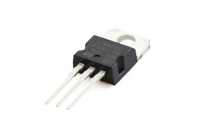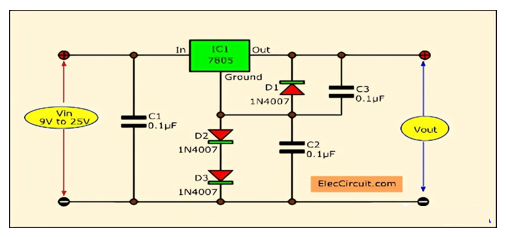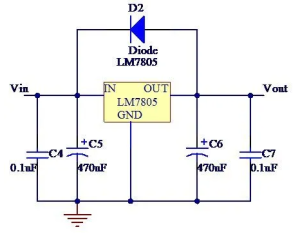LM7805 Comprehensive Guide: Pin Assignments, Parameters, and Applications
Catalog
Introduction to LM7805

LM7805 is a commonly used three-terminal voltage regulator device. Among them, "78" means that it is a positive voltage regulator, capable of producing a positive voltage with respect to ground. "05" represents its output voltage value, which provides a +5 volt regulated power supply. LM7805 is easy to use and can convert the input DC voltage into a stable DC regulated power supply with a simple circuit.
The LM7805 constitutes a 5V regulated power supply with an output voltage of +5V and an output current of up to 350mA. The regulated power supply consists of filter capacitors C1 and C3, self-excitation prevention capacitors C2 and C3, and a fixed three-terminal voltage regulator (7805) with an LC filter pole added to the rear stage. The design of the entire circuit is simple and convenient, and its input DC voltage range is 7V to 18V. After this DC voltage is filtered by the LM7805's voltage stabilizing and filter capacitors, a DC output voltage with high precision and good stability is generated at the output end of the regulated power supply. This regulated power supply can be used as a power supply for TTL circuits or microcontroller circuits. Because of its low cost, small size and good performance, it has become the most widely used monolithic integrated voltage stabilizing device in regulated power supplies.
Alternatives and equivalents:
• KA340T05
• LM340T
• LM7805CT
LM7805 Voltage Regulator Pinout

Pin 1 (Input): In this pin of the IC, positive unregulated voltage is given in regulation.
Pin 2 (Ground): This pin is neutral for equally the input and output.
Pin 3 (Output): The output of the regulated 5V is taken out at this pin of the IC regulator.
Detailed Parameters of LM7805 Voltage Regulator
• Maximum junction temperature: 125°C
• Output voltage range: 4.8V to 5.2V
• Package: available in TO-220 and KTE packages
• Load regulation: The load is usually regulated to within 10mV and less than 50mV.
• Typical output voltage: The typical LM7805 provides a stable 5V output voltage. However, due to manufacturing tolerances and operating environment changes, the actual output voltage of some models may fluctuate within a small range, typically between 4.8V and 5.2V.
• Maximum input voltage: 30VDC. If the input voltage is too high, since the LM7805 needs to limit and regulate the current to maintain a stable output voltage, it may generate large internal power consumption, which can easily cause the device to heat up.
• Peak output current: The TO220 version of the LM7805 can typically provide up to 1A of output current when using a common heat sink. However, if mounted to a suitable heat sink, it can dissipate heat more efficiently, allowing higher output current, but usually not exceeding its rating.
• Internal overload and short-circuit current protection: If the LM7805 regulator runs for too long and begins to overheat, its built-in thermal protection circuit automatically shuts down the chip until the temperature returns to a safe level.
Functions of LM7805 Voltage Regulator
LM7805 has the following functions:
Thermal protection: LM7805 also has thermal protection function. When the internal temperature of the chip exceeds the safe range, it will automatically reduce the output voltage or disconnect the output to prevent the chip from being damaged by overheating. This helps extend the life of the LM7805 and improves system reliability.
Simplify circuit design: Using LM7805 can greatly simplify circuit design. It provides a stable 5V output and requires no additional circuitry for voltage stability. This makes it easier for designers to implement a variety of electronic devices and circuits.
Overload protection: LM7805 usually has an overload protection mechanism. When the output current exceeds its capability, it automatically disconnects the output to prevent damage to its internal circuitry. This protection mechanism ensures that the LM7805 will not be overloaded during operation.
Current limit: LM7805 has a maximum output current limit. The maximum current it can deliver is determined by the chip's specifications, usually between a few hundred milliamps and several amps. If the output current exceeds this limit, the LM7805 may reduce the output voltage or trigger other protection mechanisms.
Voltage stabilization: The main function of LM7805 is to stabilize the input voltage to an output voltage of 5V. This stability is critical for many electronic devices because many integrated circuits and electronic components are very sensitive to fluctuations in voltage. The LM7805 is capable of handling a range of input voltages (typically 7V to 35V) and converting them to a stable 5V output voltage.
Main Applications of LM7805 Voltage Regulator
LM7805 applications mainly include the following:
• Stabilized dual power supply
• Current regulator
• Positive regulator
• Adjustable output regulator
• Fixed output regulator
• Reverse bias protection circuit
• Output polarity reverse protection circuit
6LM7805 Input Voltage Stabilization Circuit Diagram
The following is the input voltage regulator circuit diagram of LM7805:

As can be seen from the figure above, the input power is first filtered through a filter capacitor C1, and then enters the input pin VIN of the LM7805. This can effectively eliminate high-frequency noise and ripples in the input power supply and ensure the operating stability and accuracy of the LM7805.
7. How to Use a Diode to Change the Voltage of LM7805?
When current flows through a forward-biased diode, the voltage across it is very stable across each diode, typically remaining at about 0.65V. In the following circuit, we have added diodes D2 and D3 (1N4148) in series between the input of IC1 (most likely a voltage regulator such as the LM7805) and ground. Since these two diodes are in series, their total voltage drop will be 1.3V (0.65V from each diode added), so the output of this circuit is 6.3V (1.3V + 5V). Additionally, we added a diode D1 to protect the regulator from damage. D1 is reverse biased and may turn on when the load current flows in the reverse direction or the output voltage rises abnormally, thereby absorbing the current spike to protect the circuit. At the same time, we added two capacitors C1 and C3 to filter out transient noise and ensure that the voltage regulator IC1 outputs a stable voltage. The addition of capacitor C2 across diodes D2 and D3 may be used to further improve the stability of the regulator and reduce noise at the output.

8. How to Ensure the Stability of the Output Voltage When Using LM7805?
Avoid overload use: Exceeding the rated load of LM7805 will cause overheating and output voltage drop. Therefore, we should pay attention to avoid overload use, reasonably select the size and number of load resistors, and ensure that the output current is within the rated range of LM7805.
Consider environmental factors: Environmental factors such as temperature, humidity, etc. will also affect the output voltage stability of the LM7805. Hence, for real-world use, it's crucial to factor in how environmental conditions affect the LM7805 and implement necessary steps to mitigate their influence on voltage stability.
Application of parallel resistor: In some cases, we can add a resistor in parallel to the output of LM7805 to adjust the output voltage. By adjusting the resistance of the parallel resistor, the size and stability of the output voltage can be changed. However, it should be noted that the resistance of the parallel resistor should be calculated and selected according to actual needs to avoid adverse effects on the performance of the LM7805.
Use appropriate heat dissipation measures: LM7805 will generate a certain amount of heat during operation. If heat dissipation is poor, the output voltage will be unstable or the device will be damaged. Therefore, we should choose appropriate heat dissipation measures according to the actual situation, such as installing radiators, fans, etc., to ensure the normal operation of the LM7805 and the stability of the output voltage.
Choose the appropriate input voltage range: The input voltage range of LM7805 is usually 7V to 35V. In practical applications, in order to ensure the performance and reliability of the voltage regulator, we should select an appropriate input voltage range according to specific needs and ensure that the input voltage stability and ripple are controlled at a low level. In order to achieve this goal, we can use filter capacitors to reduce noise and interference at the input, thereby improving the stability of the LM7805 output voltage.
Frequently Asked Questions [FAQ]
1. What capacitors to use with LM7805?
This regulator does not require capacitors for stability. We recommend at least 10 uF electrolytic capacitors on both input and output. 0.33 uF into the input pin and a 0.1 uF into the output pin.
2. Which is better LM317 or 7805?
The ability for adjustable voltage: LM317 can give an adjustable output voltage in the range of 1.5V to 37V, where LM7805 can only give an output voltage of 5V.
3. What does LM stand for in LM7805?
The LM prefix (which stands for Linear Monolithic) is used by National Semiconductor. Most of the 78 series regulators I have in my component drawers are either μA (Fairchild) or SN (Texas Instruments) prefix.
4. What is the difference between LM7805 and 7805?
The terms “LM7805” and “7805” both refer to the same type of voltage regulator. The LM prefix indicates that the component is manufactured by National Semiconductor (now a part of Texas Instruments), and it's often included for clarity.
5.What is LM7805 used for?
The LM7805 voltage regulator operates by comparing the output voltage with an internal reference voltage and adjusting the pass transistor accordingly. Its primary function is to regulate the voltage supplied to electronic devices, ensuring they receive a stable and constant +5V DC power source.